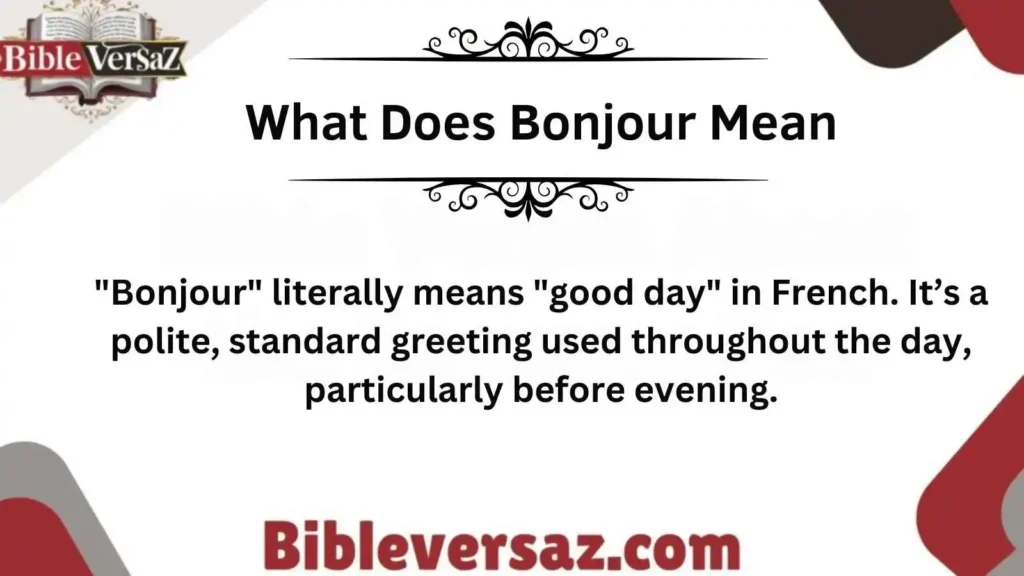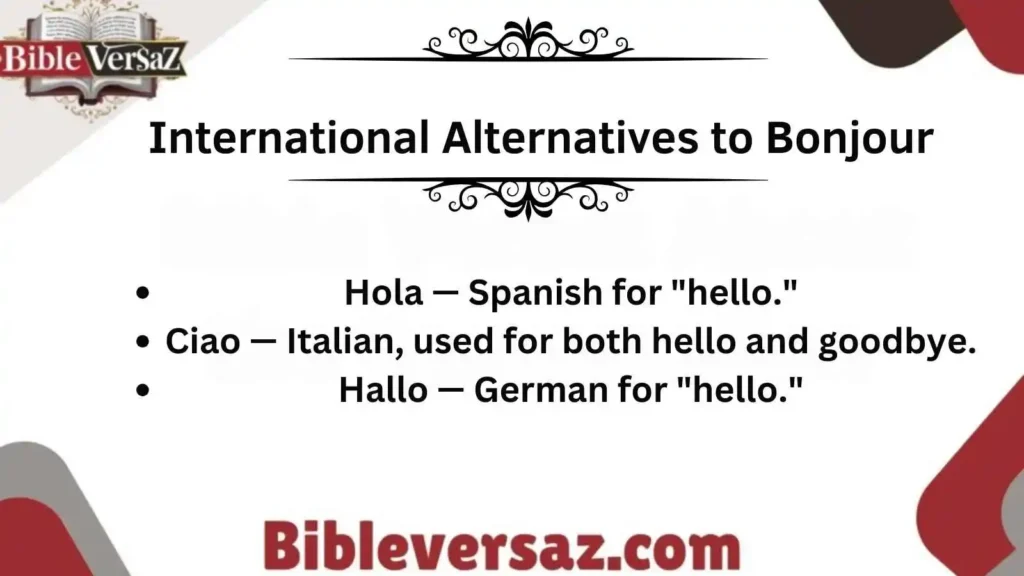The word “bonjour” is more than just a French greeting; it’s a gateway to politeness, warmth, and cultural connection.
Whether you’re learning French or simply want to diversify your greetings in English, understanding alternatives to “bonjour” can help you sound thoughtful, respectful, and engaging.
This article explores a variety of ways to say “hello” across different contexts, offering formal, professional, and casual alternatives.
What Does “Bonjour” Mean?

“Bonjour” literally means “good day” in French. It’s a polite, standard greeting used throughout the day, particularly before evening. While simple, it carries a tone of friendliness and respect, making it suitable for both professional and social settings.
Formal Alternatives to “Bonjour”
In professional or polite contexts, it’s important to greet people with warmth and respect. Here are some refined alternatives:
- Good morning — A direct and polite way to start the day.
- Good afternoon — Appropriate from noon until evening.
- Greetings — Slightly old-fashioned but formal and respectful.
- Salutations — A friendly, literary alternative.
- How do you do? — Traditional, especially in British English, often paired with a handshake.
Casual Alternatives to “Bonjour”
For informal conversations with friends, family, or acquaintances, you may want a more relaxed and friendly greeting:
- Hi — Simple and universally accepted.
- Hey — Casual and approachable.
- Hello there! — A cheerful and friendly opener.
- What’s up? — Informal and engaging.
- Yo! — Playful and ultra-casual.
Professional Alternatives to “Bonjour”
When you need to maintain a professional tone while fostering a warm rapport, these alternatives work well:
- Good day — Formal but friendly.
- Pleasure to meet you — Excellent for first introductions.
- Hope you’re doing well — Polite and considerate.
- Nice to see you — Warm without being overly familiar.
- I trust you’re having a good day — Polished and professional.
International Alternatives to “Bonjour”

If you’re communicating with people from different cultural backgrounds, knowing international greetings can build rapport:
- Hola — Spanish for “hello.”
- Ciao — Italian, used for both hello and goodbye.
- Hallo — German for “hello.”
- Konnichiwa — Japanese for “good afternoon.”
- Namaste — Hindi greeting with a respectful bow.
Contextual Nuances: When to Use Which Greeting
Choosing the right greeting depends heavily on the context. Here’s how to navigate these choices:
- Business settings — Stick with formal greetings such as “Good morning” or “Hope you’re doing well.”
- Social gatherings — A simple “Hi” or “Hey” works best.
- Networking events — Opt for “Pleasure to meet you” or “Nice to see you again.”
- Emails and messages — “Greetings” or “Dear [Name]” adds a professional touch.
Adding Warmth to Your Greetings
A simple greeting can set the tone for an entire conversation. Adding warmth and friendliness can make a difference:
- Smile when you say it — Even over the phone, a smile comes through in your tone.
- Use the person’s name — “Good morning, Alex!” feels warmer than just “Good morning.”
- Add a kind question — “Hi, how have you been?” creates connection.
Texting Alternatives for “Bonjour”
Texting requires a balance of friendliness and efficiency. Here are ten user-friendly examples:
- ✨ Morning! How’s your day looking?
- 🌟 Hey there! Hope you’re doing great.
- 🌞 Good morning! Ready for a productive day?
- 👋 Hi! What’s new?
- 💡 Hello! Got time for a quick chat?
- 🌺 Good day! Thinking of you.
- 🌼 Yo! What’s happening?
- 💧 Hiya! Staying cool today?
- 🌝 Morning sunshine! Let’s crush it today.
- 🔥 Hey! Coffee soon?
When Not to Use “Bonjour”
While “bonjour” works beautifully in most cases, there are times when another greeting may be more appropriate:
- Evenings — Switch to “Bonsoir” (good evening) in French or “Good evening” in English.
- Close friendships — Opt for casual greetings like “Hey” or “Yo.”
- Urgent situations — A quick “Hi” or “Hello” works better than formalities.
Conclusion
“Bonjour” is a versatile and warm greeting, but expanding your vocabulary of polite and professional alternatives enriches your communication skills. By selecting greetings based on context and tone, you can create stronger connections, whether in business, friendships, or international conversations. Try out different alternatives, and you might find that a simple “Good day” or “Hey there” opens doors you never expected.

James Wilson brings a deep reverence for scripture and a talent for storytelling to BibleVersaz.com. His insightful reflections and thoughtful interpretations inspire readers to connect with biblical truths on a personal level, offering fresh perspectives on timeless wisdom.


